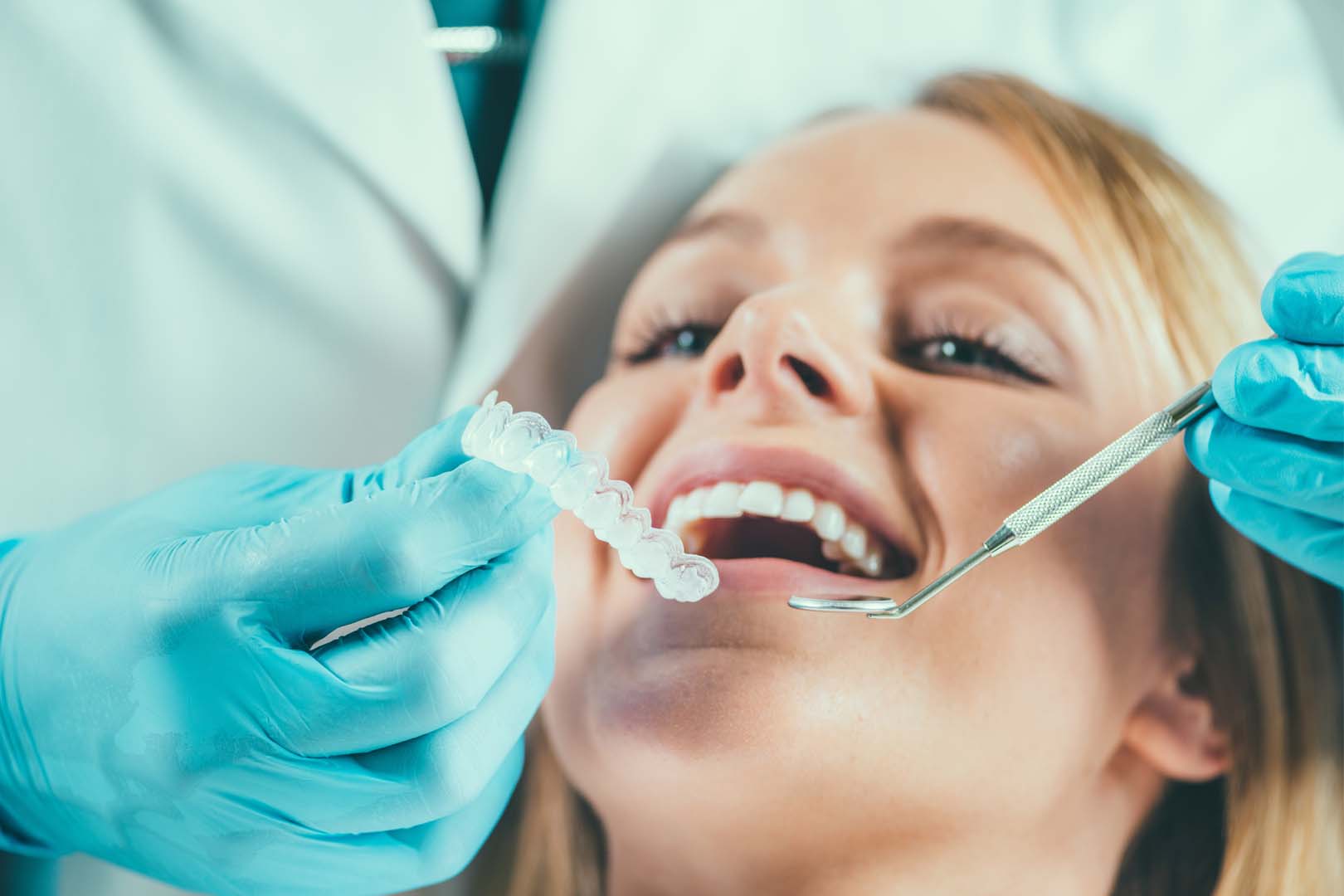The orthodontic therapy involves putting the teeth in the best possible position and achieving harmony of the mouth and jaw.
Our vision is a blend of orthodontics and aesthetics – a modern fixed prosthesis in the service of health and beauty. The orthodontic treatments are performed in accordance with nature. The most important and most valuable thing is to save your teeth. Orthodontics helps us to do this and creates a natural harmony of face and smile.
The goal of orthodontic therapy is to achieve a proper and aesthetic look of the bite, which will allow optimal chewing and redistribution of forces so that we get equal load on all teeth.
Also, a proper tooth arrangement facilitates their cleaning, which reduces the incidence of caries and also reduces the incidence of other problems, such as excessive abrasion of teeth surface, irregularities and etc. The orthodontic treatment is performed by a specialist orthodontist, and the length of treatment depends on the timeliness of the procedure. It is ideal to start treatment at a young age, not only for aesthetic reasons, but also to prevent problems later in life. Patients are offered the most advanced technology and dental techniques that achieve superior results in a much shorter period.
If you have any questions, please contact us at: [email protected] or +389 (0) 44 344 414
To schedule an examination, click here

Categories
Specialist examination of patients with complete medical documentation and X-ray diagnostics (RTG-dental status-panoramic imaging, retro-alveolar imaging, bite x-ray, profile imaging, hand radiography)
Anatomical imprint of the patient’s jaws and design of study models
Gnatometric analysis of the study model and making a definitive diagnosis
Preventive orthodontic measurements
Integrated orthodontic therapy, myofunctional exercises and the use of interceptors: inclined plate, chin holder, spatula training, space guards, vestibular plate, selective tooth formation
Treatment of jaw anomalies and teeth with active mobile apparatus;
Treatment of jaw and tooth abnormalities with functional apparatus (Andresen-Haupl activators, Balters bionators, Stockfisch, Karwetzky, Grude, Bimller, Frankel function regulator, Twin-block apparatus, positioners)
Treatment of jaw and tooth anomalies with fixed orthodontic appliances (edgewise technique, arch technique, lingual and palatal arches – Guskarijan arch)
Orthodontic maxillary spreading apparatus (Hyrax Screw, Quad Helix)
Treatment of severe anomalies of the jaw and teeth using Headgear, Delayer mask
Preoperative and post-operative treatment of patients with cleft lip, jaw and hard palate (heilognatopalatoshiza) (manufacture of obturators, active orthodontic treatment with mobile and fixed orthodontic appliances)
Treatment of patients with orofacial region syndromes
Orthodontic surgical treatment of impacted teeth (fangs, cutters, molars, third molars)
Orthodontic treatment of patients with jaw dysfunction (temporomandibular joint) and mandibular neck fracture
Treatment of patients with bruxism
Orthodontic – prosthetic treatment of patients
Orthodontic treatment in adult patients
Transparent dentures
In-visioning (transparent and removable)
Orthodontic fixation of jaws for weight loss / control
Night snoring prevention devices
Porcelain dentures for adults
Magical – fluorescent dentures
What is Invisaling – an invisible denture for teeth straighting?
The teeth straightening without dentures is a very popular method. It involves making foils for moving teeth that should not be confused with fixed prosthesis foils, which help us maintain our success.
The Invisalign system can be said to be a revolutionary technique. This type of therapy is very simple and convenient for the patient. Nothing is visible on the teeth – the foils are completely transparent and therefore meet high aesthetic criteria. This is especially important for adult patients whose profession is not allowed to wear a steel fixed prosthesis. There are also no restrictions on the choice of food for eating, such as patients undergoing fixed prosthesis therapy. Another great advantage is that the checks do not have to be done once a month, but can take months between visits to the dentist. This is especially practical for patients living abroad.
The procedure is as follows:
At the first visit, a specialist in orthopedics of the jaw performs a thorough examination of the mouth and teeth. An important part of this meeting is talking to the patient about the goals and opportunities of the therapy. The doctor takes a print with a fork, which is then sent to a computer scan technician. After a few days, the patient receives clear and precise information about the number of foils the patient has to carry in order for the teeth to be straightened. The patient will also look at a video presentation that will show him/her exactly how his/her teeth are planned to be moved and what the expected outcome will be. It is very practical and useful for the patient to know what the outcome will be before starting treatment. This provides additional motivation for each patient.
After a few days, the patient receives teeth-correcting foils and detailed instructions on how to wear and maintain them. In addition, a detailed photograph of patients is made during that visit so that the progress of therapy can be easily tracked.
How long does it take to straighten the teeth with foil?
Each foil is worn for one month, on average 18 hours a day. After that period, that first foil is deposited and the patient takes the second foil, which she carries for the next month. The length of treatment depends on the severity of the problem, i.e. the number of foils we need to fix the teeth. While some minor irregularities require 2-3 foils (2-3 months), in some serious cases it may take up to 12 foils (one year).
After reaching the goal and checking the orthodontist, it enters the retention phase – the patient continues to carry the last foil in order to maintain the results achieved. It is no longer necessary to carry the foil for 18 hours, but only to wear it at night.
Trainers are orthodontic devices that can help eliminate the negative effects of oral cavity muscles and bad habits and thereby alleviate or completely cure orthodontic irregularities.
Sucking on the thumbs – an indication of the start of training therapy
The first and most common indication for starting trainer therapy is thumbs sucking – a very common bad habit that can lead to serious impairments in the function and aesthetics of the entire dental system. Therefore, it is important for the child to stop sucking his thumb by the age of three at the latest. How difficult it is, parents of children with this problem know best. This is a situation where a trainer can help us a lot.
At what age are the trainers tailored?
The trainer is tailored to a child aged 2-5 years. They are very soft, smooth and supple so they will not bother the baby in the mouth. At the same time, this will prevent the thumb from taking position between the teeth.
In addition, the trainers have a very nice design, so the children perceive them as toys and they accept them very well. It is necessary for the child to wear them all night and only for one hour during the day and the result will not be absent. Of course, we can’t expect a kid to stop sucking his thumb after he gets a trainer. This process of weaning begins slowly. Over time, the period of wearing the trainer increases so that it slowly but surely takes the place of your thumb. In doing so, the child gradually recedes from sucking on the thumb. If the child stops sucking at this age, it is often the case that the teeth continue to develop without any irregularities.
Trainers are also very useful for children who notice an irregular bite at an early age. If a child begins treatment with a trainer at the age of 2-5, we can expect to alleviate existing irregularities and, in many cases, correct them.
Trainers for older children
If you miss the second to fifth year, there are trainers designed for older children, so the healing process begins later.
Trainers for older children are also very effective, but if an orthodontic anomaly has already developed, then training is only the first phase of therapy. The second “twisted teeth” are treated with a mobile denture or fixed denture.
Also, the procedure is the same for small children who have a hard time moving away from the pacifier, have a bad habit of printing languages, etc. So, by design, the trainer balances lips, teeth, tongue and cheek in balance and thereby allows them to continue their proper development.
It should be noted that there are trainers for the adult population that can also alleviate or eliminate irregularities – Snoring.
Why should a child wear a trainer if later they will definitely wear braces?
We hear this question very often. First, the coach will certainly reduce the poor adaptation that the child tends to develop. Therefore, the total cost of therapy will be lower.
In addition, if we correct our teeth with orthodontic treatment and some bad habits persist (eg, brushing our tongue), the stability of the results will decrease and there is a greater risk of the teeth becoming “old”. Therefore, it is very important for an orthopedic specialist to find out the cause of a certain disorder and to first prescribe it to patients who need myofunctional device-trainer therapy.
Mobile dentures
What are mobile dentures?
Mobile dentures (child dentures) are mobile orthodontic appliances that move the teeth in the proper position or affect the growth of the jaw itself.
The benefits of mobile prosthetic therapy are numerous. With such dentures, it is possible to direct the growth of the jaw in a favorable direction and thereby prevent the occurrence of more serious orthodontic anomalies. Night dentures, as children are often called, are very easy to wear and easy to wear in childhood. Our technicians are very creative, so their design is particularly appealing. This approach to children certainly increases the interest in prosthesis and motivation for therapy.
When is the right time to start the mobile denture therapy?
The best time to start treatment depends on the irregularities of the child’s teeth. Some problems are corrected as early as six years old, while some irregularities wait until the age of ten in girls and twelve in boys when so-called pre-pubertal growth occurs. Therefore, it is important that every child, at the age of six and at least seven years old, is examined by a jaw orthopedics specialist who will determine if and when the right time to start therapy.
Which dentures are better, mobile or fixed?
Mobile and fixed dentures are used to correct completely different irregularities so they cannot be compared.
First, they are used to solve problems at different ages – while mobile dentures are used mainly in mixed teeth (while the child has both dairy and permanent teeth), fixed dentures are used on permanent teeth (when there are no more dairy teeth in the mouth, over the age of twelve).
Why make a mobile denture for the child when they need to wear a fixed denture after that?
Parents often contact us about this issue. This is, however, incorrect. For most orthodontic problems, where a mobile denture is indicated, the teeth can be fully corrected by wearing a mobile denture. Of course, only if the child carries it as prescribed by the orthodontist, which is a minimum of 16 hours per day. However, if the child has some of the more serious abnormalities and needs a fixed denture after the mobile denture, such a treatment plan is presented to parents at the very beginning. The mobile denture in these cases serves to alleviate irregularities, i.e. change the direction of jaw growth to desirable, which greatly improves the end result.
Of course, there are also cases where a mobile denture cannot achieve the desired result, so such patients are advised to wait in time to get a fixed denture to correct the dental anomaly.
What are fixed dentures?
Fixed dentures are our most successful ally in achieving a beautiful smile. And not just beautiful – they are also used to achieve a healthy and functional outfit.
To find out if you are a candidate for a fixed denture, you need to make an appointment with a dentist. On his first visit, he will examine you, take your fingerprints and explain if you need to take an X-ray. By the time we arrive, in just a few days, our jaw orthopedics specialist will do a thorough analysis of your x-ray and dental prints. The next meeting will tell you what your therapy will look like and what results you can expect.
Wearing a fixed denture lasts for an average of 18 months, during which you should check once a month. Straightening your teeth in this way is not painful, although many are afraid of it and avoid it. We have to say that there is sometimes a slight discomfort when chewing, but it is a fleeting sensation and does not require the use of painkillers.
If you wear a fixed denture, you should be careful when choosing food. Hard and sticky foods should be avoided.
Also, this is the time to get interdental brushes and thread and be very thorough when it comes to brushing your teeth.
Surely you are wondering how to keep your teeth in the position you have achieved in life?
After removing the fixed denture, we take the prints of making retaining foils. These sheets should be worn at night, sometime after the denture is removed, and you do not need to worry about keeping your teeth in the desired position.
Fixed dentures, invisible dentures, steel fixed dentures, aesthetic fixed dentures
There are two types of fixed dentures that are most commonly used.
These are steel (metal) and aesthetic dentures
1. Metal (steel) fixed tooth dentures
Metal (steel) fixed dentures are a standard choice. With their help we can quickly and efficiently straighten our teeth and bring you a beautiful smile. They are extremely popular, especially for the younger ones, i.e. “Teenage” population. We can play around with the colors of the ligatures that change at each checkup control. In this way, we create a completely new and interesting look for the prosthesis itself, in accordance with the patien’’s wishes.
2. Aesthetic tooth dentures (invisible fixed dentures)
An aesthetic (invisible) fixed brace is a really good choice if it is important to you how your teeth look throughout the treatment. Patients whose daily contact with people at work requires high aesthetics are in this case our target group.
There are two types of aesthetics that are most commonly used:
Sapphire dentures
Porcelain dentures
Both types look very nice on the teeth, their color practically blends with the color of the teeth, which is why they are called “invisible”.
Our partner in providing the best care for our clients is Eurolink Insurance, and more information can be found at this link.





